Table of Contents
Every day, 166 people in the USA die from traumatic brain injury (TBI) according to the Centers for Disease Control (CDC).[i] If you survive TBI, you can experience the effects for a few days. Or for the rest of your life.
TBI can result in impaired cognition and memory, loss of vision or hearing, personality changes and depression. Affecting not only those who suffered TBI but connected families and communities.
While decades of research and clinical studies have searched for pharmaceutical solutions to treat TBI, no prescription medication has been found.
As a result, millions are searching for and successfully using natural nootropic supplements to alleviate the symptoms of brain injury.
And yet, the US Food and Drug Administration put out a warning in 2014 telling consumers to ignore and avoid using dietary supplements for treating symptoms of TBI. The FDA news release claimed there was no scientific evidence to support claims that dietary supplements could in any way help an injured brain.[ii]
Turns out there is some truth in what they claim. Most of the clinical research on dietary supplements and traumatic brain injury have been done with animals. Very few have been conducted with human subjects dealing with TBI.
The thing is some of the nootropic supplements we’ll explore in this post have been used for thousands of years. Not treating TBI specifically. But the track record and user reports speak volumes.
The purpose of this post is to provide you with the latest scientific research on nootropic supplements and traumatic brain injury. You’ll learn how to recognize traumatic brain injury (including concussions).
You’ll see what happens in the human brain that’s injured. And we’ll also consider some nootropic supplements that have been scientifically, clinically shown to alleviate some of the symptoms of TBI.
But a cautionary note to start – traumatic brain injury, and even a concussion is serious. If you whacked your head hard enough that you feel some of the symptoms described in the next section, go immediately to the ER and get checked out for bleeding in your brain.
We’ll wait right here until you get back …
Recognizing Traumatic Brain Injury
Traumatic brain injury (TBI) is caused by a bump, blow or jolt to the head that disrupts normal function of the brain. Severity of traumatic brain injury can range from ‘mild’ TBI (i.e. a brief change in mental status or consciousness) to ‘severe’ TBI (i.e. extended period of unconsciousness or memory loss).
Most TBI’s are mild (mTBI) and commonly called concussions.[iii] One study in the UK found that mild TBI accounts for up to 80% of clinical traumatic brain injuries. But a simple concussion can result in cognitive impairment and white matter damage that may develop and persist for years.[iv]
Other research has shown that a concussion can result in behavioral changes, impairments in memory and attention, headache, and unsteadiness. Two or more concussions often result in severe brain injury (second impact syndrome) with a greater severity in symptoms and longer recovery time.
A study in Italy demonstrated how vulnerable the brain is after a single concussion (mTBI). A second mild concussion within 3 days resulted in profound metabolic abnormalities similar to those seen after a single severe TBI. Affecting acetyl-CoA, gene expression, neurotransmitters, and mitochondrial metabolism.[v]
Left unchecked, this type of brain injury often leads to earlier onset of age-related cognitive decline and dementia. I have conducted Personal Consultations within the last few months where traumatic brain injury led to early-onset Alzheimer’s or Parkinson’s Disease a few months after the head injury.
The American Association of Neurology developed a grading system to help diagnose and treat concussions. Early symptoms (within a few minutes to a few hours) include lack of awareness, dizziness, headaches, nausea and vomiting. Later symptoms (days to weeks) include lower attention and concentration, persistent headaches, irritability, and sleep disturbances.[vi]
The key here is being able to recognize concussion or TBI and prevent a second injury. In sports, this means getting off the field and going into recovery rather than going back into play. It could mean the difference between quicker recovery to full health or a lifetime of cognition problems.
It also means the quicker you recognize the signs of concussion or TBI, you get medical help fast. And then identify which nootropic supplements you may want to try and support your recovery from TBI or concussion.
TBI and Concussion Effects on the Brain
A blow to the head immediately sets off a cascade of events in the brain. Effecting neuron depolarization, the release of excitatory neurotransmitters, ionic shifts, changes in glucose metabolism, altered cerebral blood flow and impaired axon function.[vii]
If this all sounds like Greek to you, stay with me and I’ll do my best to walk you through the neuroscience. As simply and basically as I can. This is important to help you understand specifically what you need to repair in your injured brain. And will help identify specifically which nootropics may help support that repair.
Traumatic brain injury or concussion starts with a disruption in neuron cell membranes and axon stretching. Causing an indiscriminate flux of ions through ion channels that were previously strictly regulated.[viii]
This process causes a widespread release of several different neurotransmitters, particularly the indiscriminate release of glutamate.[ix] Which is toxic when released in excess. Resulting in a further ionic flux.
Neuron mechanisms then work at maximum capacity to restore ionic balance which depletes brain cell energy stores.
As we step through each process in the brain that gets disrupted by traumatic brain injury, we can identify specific nootropics that may be able to target and assist in each of these problems.
Axon Injury
Traumatic brain injury often results in stretching of axons within the brain. Causing ionic flux and depolarization, calcium influx and swelling of mitochondria.[x] And neurofilament compaction (the skeletal structure that supports axons).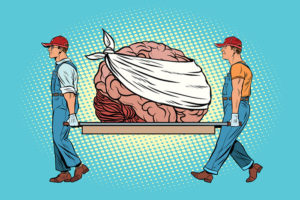
Neurofilament compaction can occur immediately after injury (5 mins. – 6 hours). And from 6 – 24 hours after you get knocked in the head, an influx of calcium can destabilize microtubules which are responsible for ions, proteins, amino acids and neurotransmitter movement into and out of the brain cell.
Axons extend from brain neurons to send messages to other neurons. The damage just described can interrupt this communication, result in axon blebbing (local swelling), and eventually the axon breaking off of the neuron.[xi]
Research has recently found that axon damage can also result from concussion (mTBI).[xii] And the damage can progress over a period of 4 – 6 weeks post-injury.
Axon damage from a concussion results in cognition problems. One study conducted in New York with 17 patients found cognitive impairment due to TBI and axon damage 8 months to 3 years after concussion![xiii]
We’ll look at nootropic supplements shown to support axon health and repair later in this post.
Cerebral Circulation
Studies have found that after TBI, cerebral blood flow decreases (hypoperfusion) the day of the injury. Day 1 – 3 blood flow in the brain increases too much (hyperemia). And days 4 – 15 after TBI, blood vessels constrict (vasospasm).[xiv] Meaning not enough blood flow to support brain cell repair and maintenance.
Cerebral blood flow and blood vessels can all be assisted with nootropics which we’ll explore in a minute.
Glutamate
When the brain is injured, neuron membranes deform. Resulting in excessive potassium release between neurons. This neuron membrane deformity also results in the release of excitatory neurotransmitters like glutamate. Which binds to NMDA and AMPA receptors and related ion channels.
The result is a widespread suppression of neurons and a condition resembling depression. Na+/K+ pumps (sodium and potassium) are activated to restore ionic balance. Because these pumps are ATP-dependent, and require high levels of glucose for metabolism, cellular energy stores are depleted.
This increase in metabolism occurs immediately and can last from 30 minutes to 4 hours after TBI.[xv] At the same time, oxidative metabolism is disrupted due to mitochondrial dysfunction.[xvi] IN turn depleting adenosine triphosphate (ATP) which brain cells use for energy.
Glucose and Mitochondria
Within 30 minutes of a concussion (mTBI), the use of glucose for metabolism rises well above normal levels. Hypometabolism (abnormally low metabolic rate) sets in after 6 hours which can last for up to 5 days.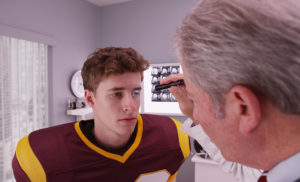
Hyperglycolysis (an increase in glucose utilization) followed by hypometabolism may last for months after moderate or severe TBI.[xvii]
NMDA channels are activated after TBI which result in a significant jump in Ca++ (calcium ions) which accumulate in mitochondria. Causing glucose oxidative dysfunction.
This oxidation is normally handled by antioxidants which prevent free radicals from damaging brain cells. With traumatic brain injury the antioxidants normally present in brain cells are insufficient to prevent brain cell damage or death (apoptosis).
Studies have found that metabolic markers such as the ATP/ADP ratio, NADH/NAD+ ratio, and N-acetylaspartate (NAA) levels all decrease after repeated concussions. Mitochondrial oxidative function is downregulated by as much as 10 days after injury.[xviii]
Animal studies have found that after TBI, the brain experiences a reduction in creatine (Cr), NAA, phosphatidylcholine (PC), and in the ATP/ADP ratio. And these findings were later confirmed in athletes with concussion.[xix] All of which can be helped with nootropics that we’ll explore later in this post.
NMDA Receptors
NMDA channels are associated with long-term potentiation (LTP) which is required for learning and the encoding of long-term memory.
It comes as no surprise that LTP is impaired after traumatic brain injury. Resulting is problems with memory. Problems with LTP manifest within 2 days of injury. And seems to recover within 7 – 15 days after injury. But LTP deficiency has been shown to last up to 8 weeks after TBI.[xx]
Nootropics to support NMDA receptor functionality and long-term potentiation will be explored in the next section of this post.
Nootropic Supplements for TBI or Concussion
Decades of research and clinical studies have shown that traumatic brain injury or concussion results in problems with ion balance, excess neurotransmitter activation, integrity of axons, brain cell energy metabolism and cerebral blood circulation.
This knowledge helps us identify nootropics from our List of Nootropics that can address each problem. And it turns out that several nootropics have been studied extensively specifically for treating the symptoms of traumatic brain injury. Particularly related to sports injuries.
If you’ve spent any time on Nootropics Expert®, it seems that most of the nootropics reviewed here could help repair and maintain an injured brain. So let’s narrow the list to supplements that have shown promise through therapeutic applications for TBI in actual clinical trials.
Creatine
As a nootropic, creatine is one of the most effective cognitive enhancers available. This non-essential amino acid is naturally synthesized in your liver, kidneys and pancreas. And used in your brain to provide a phosphate molecule to adenosine diphosphate (ADP) to produce adenosine triphosphate (ATP). ATP is the primary cellular fuel source created in brain cell mitochondria.
Studies have found that metabolic markers including the ATP/ADP ratio decrease due to traumatic brain injury. Part of the problem may be a drop in creatine from TBI.[xxi]
Maintenance of brain cell ATP levels is critical for the cellular energy required to maintain proper neuron membrane potential, ion gradients underlying brain signaling, intracellular calcium homeostasis, neurotransmission, and intracellular and intercellular signal transduction.[xxii]
A study in Greece worked with 30 children aged 1 – 18 years who suffered from TBI. The children were given 0.4 gr/kg of creatine per day for 6 months. The study found a reduction in post-traumatic amnesia, shorter intensive care stay, and improvements in recovery, communication, locomotion, sociability, personality and behavior and cognitive function.
The Greek study concluded that “administration of creatine may be beneficial to patients with traumatic brain injury”.[xxiii] Recommended dosage of Creatine for cognitive benefit is up to 5 grams per day.
DHA (Omega-3)
Omega-3 fatty acids (DHA & EPA) are important structural components of brain cell membranes. Modulating membrane fluidity, thickness, brain cell signaling and mitochondrial function.[xxiv]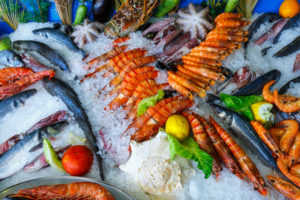
DHA (docosahexaenoic acid) influences the phospholipid content of brain cell membranes increasing phosphatidylserine (PS) and phosphatidylethanolamine production and promoting neuron growth throughout your life.
Many clinical studies with animals have shown the DHA and/or EPA supplementation benefits for traumatic brain injury recovery. DHA has been shown to significantly reduce the number of swollen (blebbing), disconnected and injured axons when taken following traumatic brain injury.[xxv]
DHA is an antioxidant and anti-inflammatory,[xxvi] reduces AMPA-mediated cell death, reduces glutamate-induced toxicity, increases nitric oxide production for cerebral circulation, normalizes brain-derived neurotrophic factor (BDNF) levels, and generally helps restore brain cell homeostasis following TBI.
Despite all the positive animal research showing benefits of Omega-3’s and DHA in recovery from TBI, so far we have no human clinical trials to verify these benefits in humans.
But growing clinical experience by numerous health care professionals show that the brain needs to be saturated with high doses of Omega-3’s in order for the brain to heal after injury. Without sufficient DHA and EPA, healing is less likely to happen.[xxvii]
Green Tea
In 1998, a study was conducted in China including subjects from 12 provinces aged 35 – 60 years. In all, 14,212 people participated in this study to investigate the association between tea consumption and stroke.
The study concluded there was a 40% decreased risk of stroke in those who drank green, black or jasmine teas.[xxviii]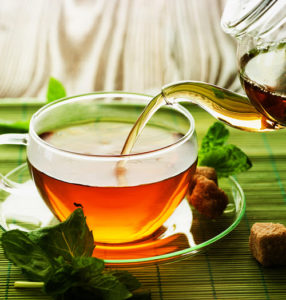
No human clinical trials have been done with green tea and traumatic brain injury. But the cognitive benefits of green tea are so profound, it must be included in this list of nootropics to benefit TBI and concussion.
TBI comes with severe oxidative stress, neuron injury, cerebral blood flow problems and inflammation. Green tea addresses all of these issues.
Green tea’s neuroprotective qualities include the flavonoid epigallocatechin-3-gallate (EGCG), the amino acid L-Theanine and methylxanthines which provide caffeine.
EGCG modulates nitric oxide and oxidative stress.[xxix] Green tea polyphenols potentiate nerve growth factor which is needed to regrow neurons.[xxx] L-Theanine delays neuronal cell death. EGCG is an anti-inflammatory and protects cell signaling pathways.
You can think of green tea as a fertilizer for nerve growth factor and L- Theanine as a silent hero that puts the brakes on neuronal cell death.
And EGCG reduces beta-amyloid mediated cognitive impairment and modulates tau pathology implicated in Alzheimer’s.[xxxi] And are associated with successive concussions or severe TBI.
We do have human studies showing that green tea extract and L-Theanine improves memory and brain theta wave activity which boosts cognitive alertness.[xxxii] A primary benefit in anyone dealing with a concussion.
Some professionals caution about the caffeine content in green tea when it comes to traumatic brain injury. But caffeine-mediated neuroprotection include reductions in neurological deficits, cerebral edema (brain swelling), brain cell apoptosis and protection from inflammation.[xxxiii]
Lithium Orotate
Glutamate toxicity plays a major role in brain damage from traumatic brain injury. Over-activity of glutamate on NMDA receptors causes apoptosis. Lithium inhibits this overactivity.
A study conducted by Dr. Peter Leeds and his team in 2014 states that lithium had “demonstrated robust beneficial effects in experimental models of Traumatic Brain Injury (TBI).
These include decreases in TBI-induced brain lesion, suppression of neuroinflammation, protection against blood-brain barrier disruption, normalization of behavioral deficits, and improvement of learning and memory, among others.”[xxxiv]
Lithium Orotate recommended dose is 5 mg 2 or 3-times per day. Naturopathic doctors suggest stacking Lithium Orotate with 1,000 mg of Omega-3 and 400 IU of Vitamin E (as mixed tocopherols). Excellent advice for anyone. Including those dealing with TBI or concussion.
N-Acetyl L-Cysteine (NAC)
N-Acetyl L-Cysteine (NAC) is a precursor of glutathione which is a potent antioxidant, anti-inflammatory and free radical scavenger. All problems that come with TBI. NAC also reduces irritability, anxiety and depression. Also associated with TBI.
A double-blind, placebo-controlled study was conducted with soldiers at a forward-deployed field hospital in Iraq. The soldiers in this study were dealing with mTBI after being exposed to blasts on the battlefield.
The soldiers were suffering from dizziness, hearing loss, headache, memory loss, sleep disturbances and neurocognitive dysfunction. All symptoms you may recall of concussion or mTBI.
The soldiers who were treated with N-Acetyl L-Cysteine (NAC) reported no symptoms after 7 days of supplementing with NAC. The researchers reported that “This is the first demonstration of an effective short term countermeasure for mTBI”.[xxxv]
Recommended dosage of NAC is 600 mg three-times per day.
Pine Bark Extract
Pycnogenol® is a standardized extract of French maritime pine bark. This extract contains 65 – 75% proanthocyanidins (procyanidins).
Pine Bark Extract is a potent anti-inflammatory and one of the most powerful antioxidants currently known.[xxxvi] Both problems with traumatic brain injury.
Studies have shown that Maritime Pine Bark Extract is 50 – 100 times more potent than Vitamin E in neutralizing free radicals. And it helps recycle and prolong the activity of Vitamins C and E.
Pine Bark Extract helps reduce DNA damage caused by oxidation, inhibits proinflammatory gene expression, prevents glycation, inhibits brain cell membrane damage from free radicals, and reduces oxidative stress. And it can boost cerebral circulation by increasing nitric oxide activity.
I think we pretty much crossed off most of the symptoms associated with traumatic brain injury here. Recommended dosage of Pine Bark Extract is up to 300 mg per day.
Piracetam
Piracetam is a water-soluble ampakine nootropic in the racetam-family of compounds. The very first “nootropic”, Piracetam was developed by the father of nootropics, Dr. Corneliu Giurgea.
Piracetam modulates both AMPA and NMDA receptors. Both receptors as you may recall are negatively affected by brain trauma. It normalizes L-Glutamate and prevents the glutamate toxicity associated with traumatic brain injury.
Piracetam also increases cerebral blood flow. Reversing the symptoms caused by restricted blood flow after TBI.
A study conducted in Russia with 42 patients aged 12 – 18 dealing with severe traumatic brain injury symptoms for the past 1½ – 5 years. 20 patients received 1600 – 2400 mg of Piracetam daily for a month. The other 22 were used as controls.
The study concluded that Piracetam provided positive therapeutic effects on memory, attention, executive function and motor function. As well as speed of cognitive and motor performance.[xxxvii]
Recommended dosage of Piracetam is 1,600 mg 3-times per day for TBI.
Resveratrol
Resveratrol is a polyphenol stilbenoid and phytoalexin that certain plants produce in response to stress, such as injury or fungal infection. It’s a naturally occurring compound found most famously in red wine.
Resveratrol could be one of your best nootropics for controlling the damage done from TBI. Although no human studies have been conducted specifically with TBI victims.
This polyphenol increases brain-derived neurotrophic factor (BDNF) in the brain. BDNF has been called Miracle Gro for promoting repair and growth of new neurons. Resveratrol also increases cerebral blood flow.
Resveratrol as an anti-inflammatory is a potent inhibitor of TNF-α- and IL-1b-induced NF-kB activation. And it suppresses COX-2 by blocking NF-kB activation.
And Resveratrol prevents the release of toxic glutamate during a stroke. Even protecting the brain when administered 6 hours after stroke.[xxxviii] This sounds like a strong therapeutic candidate to be used within the first few hours of concussion to prevent further brain damage.
Pre-clinical studies have explored Resveratrol’s therapeutic effect on experimental TBI. Studies show it reduced neuron loss after TBI in animals. And improved locomotion, anxiety and memory.[xxxix]
Recommended dose of Resveratrol extract (99%) from Japanese Knotweed for brain damage caused by TBI and increasing cerebral blood flow is 250 – 500 mg.
Pramiracetam
Pramiracetam is a fat-soluble nootropic in the racetam-family of compounds. It was first synthesized by Parke-Davis scientists in the late 1970’s. In 1991, Pramiracetam was licensed to Cambridge Neuroscience Inc. And tested for restoring cognitive function after stroke or traumatic brain injury.
Pramiracetam increases nitric oxide activity in your brain. Which acts as a vasodilator which relaxes blood vessels. Improving cerebral blood flow which is a problem after TBI.
This nootropic also has a profound effect on the synthesis of acetylcholine. Which is critical for encoding new memories, concentration, cognition and neuroplasticity.
A study in Russia was conducted with 65 patients suffering from concussion. The researchers gave half the patients Pramiracetam and the other half received Piracetam.
Tests were carried out on the first, tenth and after thirty days. Both groups noted a considerable reduction in headaches, dizziness and nausea. But the Pramiracetam group reported better restoration of orientation, feeling and said it was more effective on amnesia.[xl]
Recommended dosage for Pramiracetam is 250 – 400 mg per day. For TBI you may go up to 1,500 mg per day.
Since this nootropic has a significant effect on acetylcholine, you should stack it with a choline supplement like Alpha GPC or CDP-Choline. And because it’s fat-soluble, take it with a tablespoon of unrefined, extra virgin coconut oil for absorption.
Oxiracetam
Oxiracetam is a water-soluble ampakine nootropic in the racetam-family of compounds. And in 1977, was the 3rd racetam nootropic to be developed.
Oxiracetam modulates both AMPA and NMDA receptors which prevents the glutamate toxicity associated with TBI. It also seems to prevent an imbalance of acetylcholine activity which should also benefit those recovering from brain injury.
Oxiracetam enhances protein kinase C (PKC) which affects M1 acetylcholine receptors. Oxiracetam even demonstrates the ability to repair these receptors when damaged. Such as from traumatic brain injury.[xli]
In a study done with Wistar rats dealing with TBI, researchers showed the rats who received Oxiracetam had significantly less brain impairment 7, 14 and 21 days after brain injury.[xlii]
While I don’t have access to any human trials with Oxiracetam and traumatic brain injury, this nootropic looks like a promising addition to any stack for someone recovering from TBI.
Recommended dosage of Oxiracetam is 750 – 1,500 mg per day split into two doses. Since this nootropic boosts acetylcholine in your brain, you should stack it with a good choline source like Alpha GPC or CDP-Choline.
Turmeric
Turmeric is one of the most studied herbs in Ayurvedic, Siddha, Unani and Chinese healing. This perennial shrub native to southern Asia has been used as medicine for at least 6,000 years.
Turmeric, or any one of its several active compounds including curcumin and Ar-turmerone undoes damage to your brain caused by depression, chronic stress and traumatic brain injury.
Turmeric and curcumin boosts neurogenesis, increases dendrites, repairs DNA, reduces inflammation, counters free radical damage, and boosts neurotransmitters when needed. All problems identified in TBI.
In one animal study, researchers in Germany found that Ar-turmerone, one of the many components extracted from turmeric, increased neural stem cells in the brain. Promoting the creation of new brain cells.[xliii]
Another study conducted at UCLA found that curcumin counteracts the outcome of traumatic brain injury on oxidative stress, synaptic plasticity and cognition.[xliv]
To obtain the cognitive benefits needed for healing traumatic brain injury, both Turmeric and Curcumin seem to be the best option. DolCas Biotch developed a standardized extract of turmeric containing curcumin-essential oil complex of 86% curcuminoids and 7-9% essential oils. Including the turmeric volatile oil Ar-turmerone. It’s called BCM95®.
If you choose a turmeric supplement containing BCM95®, follow the dosage directions on the label. Otherwise, recommended dosage for Turmeric extract (95% curcuminoids) is 750 mg 3-times per day.
Vinpocetine
Vinpocetine is a semi-synthetic derivative of vincamine, an alkaloid derived from the lesser periwinkle plant (Vinca Minor L.).
Vinpocetine is a prescription drug in Japan, Europe, Mexico and Russia for the treatment of cognitive and cerebrovascular disorders. In the USA and Canada, Vinpocetine is sold as an OTC dietary supplement.
As a nootropic, Vinpocetine is used primarily to increase cerebral blood flow.
Many of the studies using Vinpocetine for traumatic brain injury have been done with animals. For example, a study conducted at Maharaja Ranjit Singh Punjab Technical University at Punjab, India was done with rats with TBI.
The animals were suffering from a significant deterioration of cognition and motor functions. Vinpocetine reduced oxidative stress, altered neurochemistry, and improved the cognitive and motor functions as compared with that of the TBI control group.
Several studies with human stroke patients showed Vinpocetine increased glucose uptake and glucose metabolism as well as increased brain blood flow. Which is directly related to some of the problems caused by traumatic brain injury and concussion.
Vinpocetine side effects are rare. But it can lower blood pressure, decrease clotting and should be avoided if you have low blood pressure or bleeding issues.
And women who are pregnant should avoid Vinpocetine because it can decrease fetal weight and increase the chance of a miscarriage.
I highly recommend Vinpocetine 10 mg 3-times per day and every day long-term. I’ve been using Vinpocetine every day for well over 10 years.
B-Complex Vitamins
Any nootropic supplement stack used for traumatic brain injury or concussion recovery should include a high quality, bio-available B-Complex vitamin. Here’s why …
- Vitamin B6 (Pyridoxine) – is needed to control inflammation caused by elevated homocysteine. It’s a cofactor in the synthesis of dopamine, epinephrine, GABA, norepinephrine and serotonin. Vitamin B6 has a direct effect on your immune system, gene transcription and expression and is involved in glucose regulation.
- Vitamin B8 (Inositol) – helps boost serotonin and dopamine receptor density. Improves the effectiveness of all major neurotransmitters in your brain. Myo-inositol affects mRNA which regulates cell volume, controls cellular signaling, plays a role in DNA repair, is a component of brain cell membranes, regulates cell metabolism and energy consumption and affects long-term potentiation.
- Vitamin B9 (Folate) – is involved in DNA and RNA synthesis, gene expression, amino acid synthesis and metabolism, and myelin synthesis and repair. Folate is required for synthesis of dopamine, epinephrine and serotonin.
- Vitamin B12 (Methylcobalamin) – Methylcobalamin, the type of B12 your body uses, is needed to control inflammation by regulating homocysteine, is a cofactor in the synthesis of dopamine, GABA, norepinephrine, and serotonin. And helps increase serotonin and dopamine levels which decrease anxiety, depression, fatigue and pain.
Choose a B-Complex that contains folate (not folic acid) and methylcobalamin (not cobalamin). I can’t imagine good recovery from traumatic brain injury or concussion without the assistance of the B-Vitamins.
Suggested Nootropic Stack for TBI or Concussion Recovery
The use of nootropic supplements and herbal remedies has become more common place. Particularly when it comes to quality recovery from traumatic brain injury or concussion.
So far, no pharmaceutical solution exists to your brain’s ability to repair from this type of injury.
When choosing nootropic supplements for your stack, do your best to select only high quality supplements from reputable manufacturers with a great track record and great customer reviews.
When it comes to plant-based nootropics, organics are best so you avoid contamination by heavy metals, and other toxins.
Follow dosage recommendations carefully to avoid side effects. And please do your homework and ensure each nootropic is not contraindicated with any of the prescription medicines you’re taking.
If I was personally dealing with concussion or traumatic brain injury, the first thing I’d do is go to the emergency room. And get checked out for bleeding in my brain.
When I got home, this is the nootropic stack I’d use, and you may want to consider as well. This is by no means medical advice. You should be consulting with your neurologist or neurosurgeon every step of the way when recovering from this type of injury.
Here’s a suggested nootropic stack to support ionic balance, neurotransmitter problems, axon damage, brain cell energy metabolism and cerebral blood flow.
- Creatine
- DHA (Omega-3)
- Lithium Orotate
- N-Acetyl L-Cysteine (NAC)
- Pine Bark Extract
- Turmeric (BCM95®) extract
- B-Complex Vitamins
- CDP-Choline
CDP-Choline is included because Pramiracetam boosts acetylcholine. And your brain needs more acetylcholine which is why you need to use a precursor like CDP-Choline. You could alternatively use Alpha GPC.
Find a green tea that you like and drink at least 4 cups per day. You could use a L-Theanine supplement. But you wouldn’t get the full benefit of all the cognitive health promoting properties of green tea.
I’d also highly recommend completely stop eating inflammation-producing foods or drink. This includes all processed food, grains, soft drinks and others. Do an Internet search for “inflammatory foods” for a full list.
It is possible to fully recover from traumatic brain injury. Not guaranteed of course. But the odds are stacked in your favor if you take action. And support your brain with what it needs to repair itself with nootropic supplements.

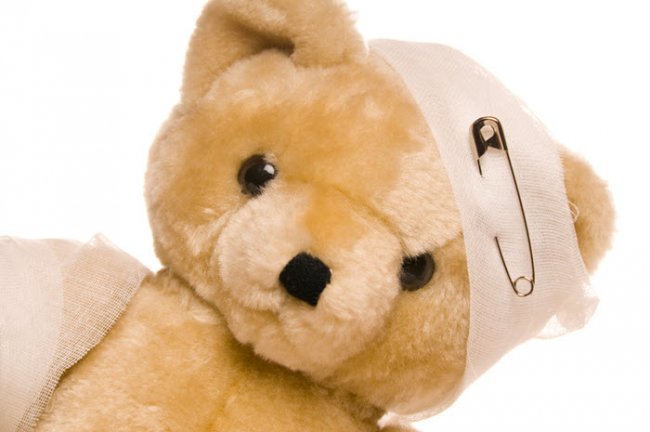

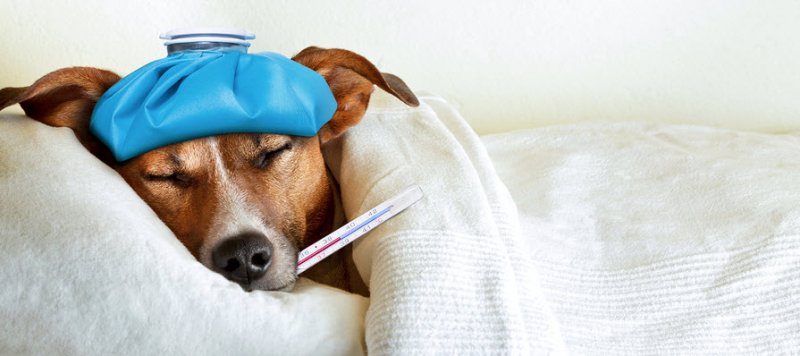






Join The Discussion - 126 comments
Violet Holt
June 11, 2025
After my stroke, I had to relearn everything—walking, moving, living. It felt like starting over, but I was determined to heal. With faith, support from my husband and family, and the herbal formula from (company name redacted), I made a natural recovery. Stroke healing starts in the brain through neuroplasticity—the brain’s ability to rewire itself. This formula supported that process, and today, I feel like myself again. Don’t give up. Recovery is possible. There are real, natural options out there.